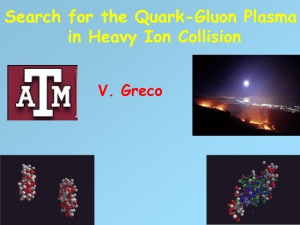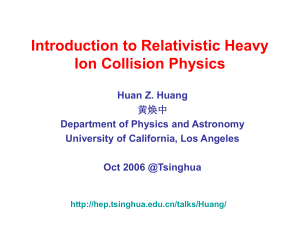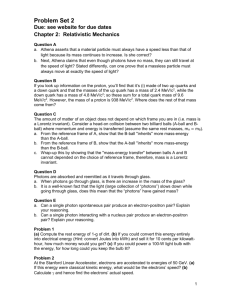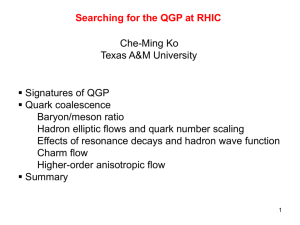Document
advertisement
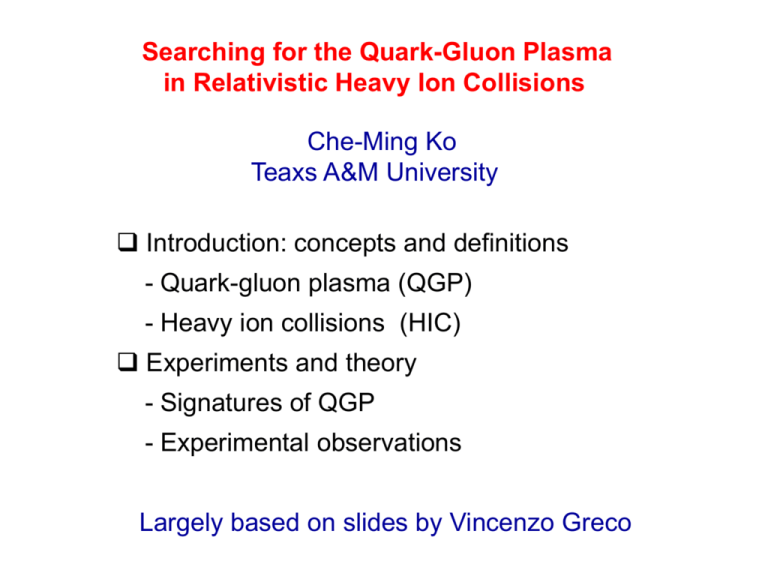
Searching for the Quark-Gluon Plasma in Relativistic Heavy Ion Collisions Che-Ming Ko Teaxs A&M University Introduction: concepts and definitions - Quark-gluon plasma (QGP) - Heavy ion collisions (HIC) Experiments and theory - Signatures of QGP - Experimental observations Largely based on slides by Vincenzo Greco Big Bang • e. m. decouple (T~ 1 eV , t ~ 3.105 ys) “thermal freeze-out “ • but matter opaque to e.m. radiation • Atomic nuclei (T~100 KeV, t ~200s) “chemical freeze-out” • Hadronization (T~ 0.2 GeV, t~ 10-2s) • Quark and gluons We’ll never see what happened at t < 3 .105 ys (hidden behind the curtain of the cosmic microwave background) Bang HIC can do it! Little Bang N D N “Elastic” finite Dt Freeze-out Hadron Gas Phase Transition Plasma-phase Pre-Equilibrium Heuristic QGP phase transition Free massless gas E g 3 4 gtot g g 78 ( g q g q ) d p p f ( p) g tot T 3 0 V (2 ) 30 g g 16 , gq gq Nc N s N f Bag Model PH EH V B C 4R 4 P 0 RH Pressure exceeds the Bag pressure -> quark liberation 37 2 904 1/ 4 B1/4 ~ 210 MeV B B > T ~ 145 MeV Tc T 2 c 90 37 1/ 4 Extension to finite mB , mI Quantum ChromoDynamics 1 m m a ψi γ m i gAa ψi mi ψi ψi Fam Fam 2 4 a i 1 nf Fam m Aa Aam i f abc Abm Ac Similar to QED, but much richer structure: SU(3) gauge symmetry in color space Approximate Chiral Symmetry in the light sector which is broken in the vacuum. UA(1) ciral Scale Invariance broken by quantum effects Phase Transition in lattice QCD Enhancement of the degrees of freedom towards the QGP 0.7 GeV / fm 3 Tc 173 15 MeV Noninteracting massless partons qq 2 7 4 g 6n f 16 T 30 4 Gap in the energy density (Ist order or cross over ?) QCD phase diagram From high rB regime to high T regime AGS SPS RHIC 2 sNN ( pA pB )2 ECMS We do not observe hadronic systems with T> 170 MeV (Hagedon prediction) Definitions and concepts in HIC Kinematics Observables Language of experimentalist The RHIC Experiments Au+Au STAR Soft and Hard SOFT (non-pQCD) string fragmentation in e+e , pp … or (pT<2 GeV) string melting in AA (AMPT, HIJING, NEXUS…) QGP HARD minijets from first NN collisions Independent Fragmentation : pQCD + phenomenology • Small momentum transfer • Bulk particle production – How ? How many ? How are they distributed? • Only phenomenological descriptions available (pQCD doesn’t work) 99% of particles Collision Geometry - “Centrality” Spectators Participants S. Modiuswescki 15 fm 0 b N_part For a given b, Glauber model 0 fm predicts N part 394 and Nbinary Kinematical observables 1 E pz y ln 2 E pz Additive like Galilean velocity y j / CM y j / LAB yLAB / CM Transverse mass mT m p 2 2 1/ 2 T E mT cosh y , pz mT sinh y Angle with respect to beam axis 1 | p | pz ln tan( / 2) ln 2 | p | pz PHOBOS Rapidity -pseudorapidity dN m2 dN 1 2 2 ddpT mT cosh y dydpT PHOBOS Energy Density | Dy | 0.5 Energy density a la Bjorken: dET 1 dET ε A T dz πR 2 τ dy Particle streaming from origin z v z tanh y t dz cosh y dy R 1.18 A 7 fm τSPS 1 fm/c Estimate for RHIC: dET/dy ~ 720 GeV Time estimate from hydro: 0.6 fm/c ~ 8 GeV/fm 3 1/3 τ RHIC 0.4 1 fm/c Tinitial ~ 300-350 MeV Some definitions I: radial collectiv flows Slope of transverse momentum spectrum is due to folding temperature with radial collective expansion <bT> from pressure. Absence 1 Non relativistic p T m , Tsl Tf m v T 2 1 vT Ultra relativistic p T >> m, Tsl Tf 1 vT 2 Slopes for hadrons with different masses allow to separate thermal motion from collective flow Tf ~ (120 ± 10) MeV <bT> ~ (0.5 ± 0.05) Collective flow II: Elliptic Flow Fourier decomposition of particle momentum distribution in x-y plane dN dN 1 2 v n cos(n ) dpT d dpT n z y x Anisotropic Flow Measure of the pressure gradient Good probe of early pressure v2 is the 2nd Fourier coeff. of particle transverse moment distribution px2 p y2 v2 cos2 px2 p y2 Anisotropic flow Anisotropic flow vn d3N dN 1 dN E 3 1 2v (p , y)cos(n ) n T d p pT dpT d dy 2 pT dpTdy n=1 Sine terms vanish because of the symmetry in A+A collisions Initial x spatial anisotropy Pressure gradient anisotropy Anisotropic flows Statistical Model Temperature Yield Maximum entropy principle Mass Chemical Potential Quantum Numbers Is there a dynamical evolution that leads to such values of temp. & abundances? Hydro adds radial flow & freeze-out hypersurface for describing the differential spectrum Yes, but what is Hydro? HYDRODYNAMICS Local conservation Laws 5 partial diff. eq. for 6 fields (p,e,n,u) + Equation of State p(e,nB) m mT ( x) 0 T m ( x) e( x) p( x)u m ( x)u ( x) p( x) g m m m jB ( x) 0 jBm ( x) nB ( x)u m ( x) No details about collision dynamics (mean free path >0) Transport Model Follows time evolution of particle distribution f q , g ( r , p, t ) from initial non-equilibrium partonic phase f p r f rU p f I coll Non-relativistically t m drift 2 2 coll Ip m m f ( fI3 1 2 3 mean field collision I I 4 1 2 2 2 2 3 f 4 f1 f 2 )W1234 ( p1 coll coll coll gg>ggg Relativistically p p 2... 3 p4 ) g>gg To be treated: - Multiparticle collision (elastic and inelastic) - Quantum transport theory (off-shell effect, … ) - Mean field or condensate dynamics at High density Transport Spectra still appear thermal Hydro Elliptic Flow rapidity rapidity • Chemical equilibrium with a limiting Tc ~170MeV • Thermal equilibrium with collective behavior - Tth ~120 MeV and <bT>~ 0.5 • Early thermalization ( < 1 fm/c, ~ 10 GeV/fm3) - very large v2 We have not just crashed 400 balls to get fireworks, but we have created a transient state of plasma A deeper understanding of the system is certainly needed! Signatures of quark-gluon plasma Dilepton enhancement (Shuryak, 1978) Strangeness enhancement (Meuller & Rafelski, 1982) J/ψ suppression (Matsui & Satz, 1986) Pion interferometry (Pratt; Bertsch, 1986) Elliptic flow (Ollitrault, 1992) Jet quenching (Gyulassy & Wang, 1992) Net baryon and charge fluctuations (Jeon & Koch; Asakawa, Heinz & Muller, 2000) Quark number scaling of hadron elliptic flows (Voloshin 2002) …………… Dilepton spectrum at RHIC MinBias Au-Au thermal • Low mass: thermal dominant (calculated by Rapp in kinetic model) • Inter. mass: charm decay No signals for thermal dileptons yet Strangeness Enhancement Basic Idea: Production threshold is lowered in QGP In the QGP: qq ss QQGP 2ms 250 300 MeV g g s s Hadronic channels: K K (Q 2mK 2m 710 MeV ) NN NK (Q m mK mN 670 MeV ) N K (Q m mK mN m 530 MeV ) Equilibration timescale? How much time do we have? QGP Scenario Hadronic Scenario Decreasing threshold in a Resonance Gas ND NK (Q 380 MeV ) D K (Q 240 MeV ) DD NK (Q 90 MeV ) r (Q 80 MeV ) To be weighted with the abundances npQCD calculation with quasi particle picture and hard-thermal loop still gives t~5-10 fm/c How one calculates the Equilibration Time d3p Tm2 1 nm req g K2 3 f ( p) 2 n T (2 ) n 1 dr S g12 v dt r1r2 v 12 SS 72 qq g12 N N N f 256 gg 2 c 2 s r SS 12 2 S Similarly in hadronic case but more channels Reaction dominated by gg 6 fm/c (pQCD) Equilibration time in QGP teq ~10 fm/c > tQGP Hadronic matter teq ~ 30 fm/c Experimental results Strangeness enhancement 1 Ej Y /N Y / N j wound AA j wound ref Strangeness enhancement 2 S 2 ss uu dd e+e- collisions Schwinger mechanism J/Y suppression In a QGP enviroment: • Color charge is subject to screening in QGP > qq interaction is weakened • Linear string term vanishes in the deconfined phase (T) > 0 deconfinement q V / TC q q,q,g distribution modified Coulomb > Yukawa V eff r eff r e r D rTC =0 doesn’t mean no bound ! Screening Effect • Abelian • Non Abelian (gauge boson self-interaction) eff (T ) 1 H e 2 mr 2 r Bound state dE ( r ) dr TBound 0.84 2 eff One loop pQCD r D ( T ) solution 0 m 2 c c g (T ) V 4 4 r D > 210 MeV 9 150 MeV Nc N f D 6 3 1.2 eff m 1.2 rBohr 1 2 gT 1 2 / 3 gT 1 0.3T latt D TBound is not Tc ! In HIC at √s ~ SPS, J/Y should be suppressed ! 1 Lattice result for V channel (J/y) A(w) w2r (w) J/y (p 0) disappears between 1.62Tc and 1.70Tc cu , cd D cs Ds c u, c d D J/Y Initial production Dissociation In the plasma c s Ds Suppression respect Recombine with to extrapolation from pp light quarks For light quarks rBohr ~ 4 fm >> D , dissociation is more effective but of course also recombination Associated suppression of charmonium resonances Y’, cc , … as a “thermometer”, like spectral lines for stellar interiors B quark in similar condition at RHIC as Charmonium at SPS NUCLEAR ABSORBTION pre-equilibrium cc formation time and absorbtion by comoving hadrons HADRONIC ABSORBTION rescattering after QGP formation J / Y h ( , r ,w,...) D D DYNAMICAL SUPPRESSION (time scale, g+J/Y > cc,…) pA (models) abs ~ 6 mb Fireball dynamical evolution Dynamical dissociation J/y + g c+c+X gluon-dissociation, inefficient for my≈ 2 mc* “quasifree” dissoc. [Grandchamp ’01] • RHIC central: Ncc≈10-20, • QCD lattice: J/y’s to ~2Tc If c-quarks thermalize: dNy d Regeneration in QGP / at Tc J/y + g c+c+X y ( Ny Nyeq ) → ← [Grandchamp +Rapp ’03] Charmonia in URHIC’s RHIC • dominated by regeneration • sensitive to: mc* , open-charm degeneracy SPS Pion interferometry open: without Coulomb solid: with Coulomb STAR Au+Au @ 130 GeV STAR Au+Au @ 130 AGeV C ( q) 1 exp( qo2 Ro2 qs2 Rs2 ql2 Rl2 ) 1 exp( q R ) 2 inv 2 inv Ro/Rs~1 smaller than expected ~1.5 Source radii from hydrodynamic model Fails to explain the extracted source sizes Two-Pion Correlation Functions and source radii from AMPT Lin, Ko & Pal, PRL 89, 152301 (2002) Au+Au @ 130 AGeV Need string melting and large parton scattering cross section which may be due to quasi bound states in QGP and/or multiparton dynamics (gg↔ggg) Emission Function from AMPT • Shift in out direction (<xout> > 0) • Strong positive correlation between out position and emission time • Large halo due to resonance (ω) decay and explosion → non-Gaussian source Jet quenching Decrease of mini-jet hadrons (pT> 2 GeV) yield, because of in medium radiation. Ok, what is a mini-jet? why it is quenched ? High pT Particle Production High pT (> ~ 2.0 GeV/c) hadron production in pp collisions Jet: A localized collection of hadrons which come from a fragmenting parton hadrons Parton Distribution Functions Hard-scattering cross-section c a b d hadrons Fragmentation Function leading particle phad= z pc , z <1 energy needed to create quarks from vacuum h d pp 0 D d 2 2 h/c K dx dx f ( x , Q ) f ( x , Q ) ( ab cd ) a b a a b b dyd 2 pT dtˆ z c abcd “Collinear factorization” Jet Fragmentation-factorization , K, p ... c b a A B dN h dN c dz Dch ( z c ) c 2 2 d ph d pc c d ph= z pc , z <1 energy needed to create quarks from vacuum AB= pp (e+e) a,b,c,d= g,u,d,s…. dN c distribution after pp2collision 2 Parton dxa dxb f ( xa , Q ) f ( xb , Q ) 2 d pc c sˆ dσ ( ab cd ) δ( sˆ tˆ uˆ ) π dtˆ a A b B (+ phenomenological kT smearing due to vacuum radiation) Dc p ( z ) Dc ( z ) 0.2 p/ < 0.2 B.A. Kniehl et al., NPB 582 (00) 514 High pT Particle Production in A+A h AB dN 2 2 ABK dx dx d k d kb a b a 2 abcd dyd pT f a / A ( xa , Q 2 ) f b / B ( xb , Q 2 ) g (k a ) g (k b ) 0 h/c * c 2 c zc* zc /(1 ) Parton Distribution Functions Intrinsic kT , Cronin Effect S A ( xa , Qa2 ) S B ( xb , Qb2 ) d (ab cd ) dtˆ 1 zc* 0 dP( ) zc pc* pc (1 ) Shadowing, EMC Effect Hard-scattering cross-section c Partonic Energy Loss D (z ,Q ) Fragmentation Function zc a b d hadrons leading particle suppressed Energy Loss ~ Brehmstralung radiation in QED Color makes a difference k pi pi pf × × pi pf a × pf c k Gluon multiple scattering Static scattering centers assumed thickness dE dx s N c qˆ L DE qˆL2 Non-Abelian gauge Transport coefficient qˆ q 2 2 m Debye x 1 w t form lcoh v k k N scatt coh lcoh / > 1 Medium Induced Radiation c M 2,1,1 Clearly similar Recursion Method is needed to go toward a large number of scatterings! Ivan Vitev, LANL Jet Quenching L/ opacity Large radiative energy loss in a QGP medium DE/E ~ 0.5 Jet distribution Non – abelian energy loss DE ( 0 ) 3α μL 2 E log 2 E 4 g μ L DE E weak pT dependence of quenching Quenching Energy Loss and expanding QGP qL 2 eff 2E d r ( , ) ln 2 m ( ) r ( ) r0 / 0 out 0 Probe the density m ( ) gT ( ) g r ( ) / 2 In the transverse plane Quenching is angle dependent dN dN 1 2 v n cos(n ) dpT d dpT n px2 p y2 v2 cos2 px2 p y2 1/ 3 How to measure the quenching Self-Analyzing (High pT) Probes of the Matter at RHIC Nuclear Modification Factor: d 2 N AA / dpT d RAA ( pT ) Ncoll d 2 N NN / dpT d nucleon-nucleon cross section <Ncoll> AA If R = 1 here, nothing new going on Centrality Dependence Au + Au Experiment d + Au Control • Dramatically different and opposite centrality evolution of Au+Au experiment from d+Au control. • Jet suppression is clearly a final state effect. Is the plasma a QCD-QGP? Consistent with L2 non-abelian plasma behavior Consistent with ~ 10 GeV (similar to hydro) Baryon-Meson Puzzle pions protons PHENIX,nucl-ex/0212014 PHENIX, nucl-ex/0304022 0 suppression: evidence of jet quenching before fragmentation Fragmentation p/ ~ 0.10.2 Jet quenching should affect both Fragmentation is not the dominant mechanism of hadronization at pT ~ 1-5 GeV !? Coalescence vs. Fragmentation Parton spectrum Fragmentation: Leading parton pT ph= z pT according to a probability Dh(z) z < 1, energy needed to create quarks from vacuum Coalescence: BM partons are already there $ to be close in phase space $ ph= n pT ,, n = 2 , 3 baryons from lower momenta Even if eventually Fragm. takes over … p p C ( pT ) T T 2 2 p F ( pT ) T z C 4 F z pT Coalescence dNm 2 3 3 VF d p1d p2 f q ( p1 ) f q ( p2 ) Μ( qq m) 3 d P Our implementation M qq m 2 npQCD 1 dNq f q ( p) VF d 3 p 2 3 W (3) p1 , p2 | P, m g m d r f m (r , q ) δ ( P p1 p2 ) 9π f D2x ( x1 x2 )2 D2p ( p1 p2 )2 (m1 m2 ) 2 2 D x 1/ D p coal. parameter |Mqq->m|2 depends only on the g m spin color probabilit y phase space weighted by wave function (npQCD also encoded Energy not conserved in the quark masses , mq=0.3 No confinement constraint GeV, ms=0.475 GeV) W m Coalescence Formula n d 3 pi dN H pi dσ i f ( xi , pi ) f H ( x1 ... xn , p1... pn )δ( pT piT ) 2 3 q d pT ( 2π ) i 1 fq invariant parton distribution function thermal (mq=0.3 GeV, ms=0.47 GeV) with radial flow b0.5) + quenched minijets (L/3.5 fH hadron Wigner function fM 9π 2 2 2 2 2 D ( x x ) D ( p p ) ( m m ) x 1 2 p 1 2 1 2 2(D x D p )3 Dx = 1/Dp coalescence radius 2 ( p1 p2 ) In the rest frame Distribution Function T=170 MeV | Dy | 0.5 soft ET ~ 700 GeV b(r) ~ 0.5 r/R T ~ 170 MeV hard L/3.5 P. Levai et al., NPA698(02)631 V ~ 900 fm-3 ~ 0.8 GeV fm-3) Hadron from coalescence may have jet structure (away suppr.) REALITY: one spectrum with correlation kept also at pT < 2 GeV Pion & Proton spectra Au+Au @200AGeV (central) ρ ππ V. Greco et al., PRL90 (03)202302 PRC68(03) 034904 R. Fries et al., PRL90(03)202303 PRC68(03)44902 R. C. Hwa et al., PRC66(02)025205 Proton enhancement due to coalescence! Baryon/Meson ratio Be careful , there are mass effects ! Resonance decays r > Shrinking of baryon phase space p Fragmentation not included for Momentum-space coalescence model Including 4th order quark flow Kolb, Chen, Greco, & Ko, PRC 69 (2004) 051901 f q (pT ) 1 2v 2,q (pT )cos(2 ) 2v 4,q (p T )cos(4 ) Meson flow v 2,M = 2v 2,q + 2v 2,q v 4,q 1 + 2(v 2 2,q 2 4,q +v ) , v 4,M = 2v 4,q + v 22,q 1 + 2( v 22,q + v 24,q ) Baryon flow v 2,B = 3v 2,q + 6v 2,q v 4,q + 3v 32,q + 6v 2,q v 24,q 2 2,q 2 4,q 2 2,q 4,q 1 + 6( v + v + v v ) , v 4,B = 3v 4,q + 3v 22,q + 6v 22,q v 4,q + 3v 34,q 1 + 6(v 22,q + v 24,q + v 22,q v 4,q ) v 4,M 1 1 v 4,q v 4,B 1 1 v 4,q ⇒ 2 = + 2 , 2 = + 2 v 2,M 4 2 v 2,q v 2,B 3 3 v 2,q Elliptic Flow from Coalescence Enhancement partonic v2 Coalescenceofscaling v 2,M (p1T ) 2v pT2,q (p T /2) V2 v 2,B (pnT ) 3vn2,q (p T /3) Wave function effects > scaling breaking 10% q/m 5% b/m wave function effect Effect of Resonances on Elliptic Flow Pions from resonances w.f. + resonance decay K&p * K, , moved p … v2 not affected coal. towards data by resonances! nucl-th/0402020 Higher-order anisotropic flows Data can be described by a multiphase transport (AMPT) model Parton cascade v4,q v22,q v4 2 1.2 ⇒ v 2v Data 4,q 2,q in naive quark coalescenc e model 2 v2 Back-to-Back Correlation trigger Assoc. quenched Trigger is a particle at 4 GeV < pTrig < 6 GeV Associated is a particle at 2 GeV < pT < pTrig Away Side: quenching has di-jet structure Same Side: Indep. Fragm. equal (?!) to pp Coalescence from s-h leads to away side suppression, While same side is reduced if no further correlation … Unexpected: Appreciable charm flow Does Charm quark thermalize? v2 of D meson (single e) coalescence/fragmentation? energy loss? pT Spectra and Yield of J/Y From hard pp collision D meson spectra V. Greco , PLB595 (04) 202 S. Batsouli,PLB557 (03) 26 D mesons D mesons B mesons No B mes. Single electron does not resolve the two scenarios Elliptic flow better probe of interaction Charmed Elliptic Flow Flow mass effect V2q from , p, , Coalescence can predict v2D for v2c = 0 & v2c = v2q V2 of electrons S. Kelly,QM04 Quenching VGCMKRR, PLB595 (04) 202 Quark gluon plasma was predicted to be a weakly interacting gas of quarks and gluons The matter created is not a firework of multiple minijets Strong Collective phenomena Hydrodynamics describes well the bulk of the matter Transport codes needs a quite large npQCD cross section Charm quark interacts strongly in the plasma Recent lattice QCD finds bound states of cc at T>Tc Rethinking the QGP at Tc < T < 2Tc “Strong” QGP Summary Most proposed QGP signatures are observed at RHIC. Strangeness production is enhanced and is consistent with formation of hadronic matter at Tc. Large elliptic flow requires large parton cross sections in transport model or earlier equilibration in hydrodynamic model. HBT correlation is consistent with formation of strongly interacting partonic matter. Jet quenching due to radiation requires initial matter with energy density order of magnitude higher than that of QCD at Tc. Quark number scaling of elliptic flow of identified hadrons is consistent with hadronization via quark coalescence or recombination. Studies are needed for electromagnetic probes and heavy flavor hadrons. Theoretical models have played and will continue to play essential roles in understanding RHIC physics. Conclusions Matter with energy density too high for simple hadronic phase ( > c from lattice) Matter is approximately thermalized (T >Tc ) Jet quenching consistent with a hot and dense medium described by the hydrodymic approach Hadrons seem to have typical features of recombination Strangeness enhancement consistent with grand canonical ensemble J/y ... Needed : - Thermal spectrum - Dilepton enhancement A Lot of work to do … Lattice QCD Effective field theory Transport theory (quantum, field condensate,…) pQCD Understanding of Non-Abelian Interaction ! Scientific approach to an important part of the evolution of the primordial plasma can be achieved
